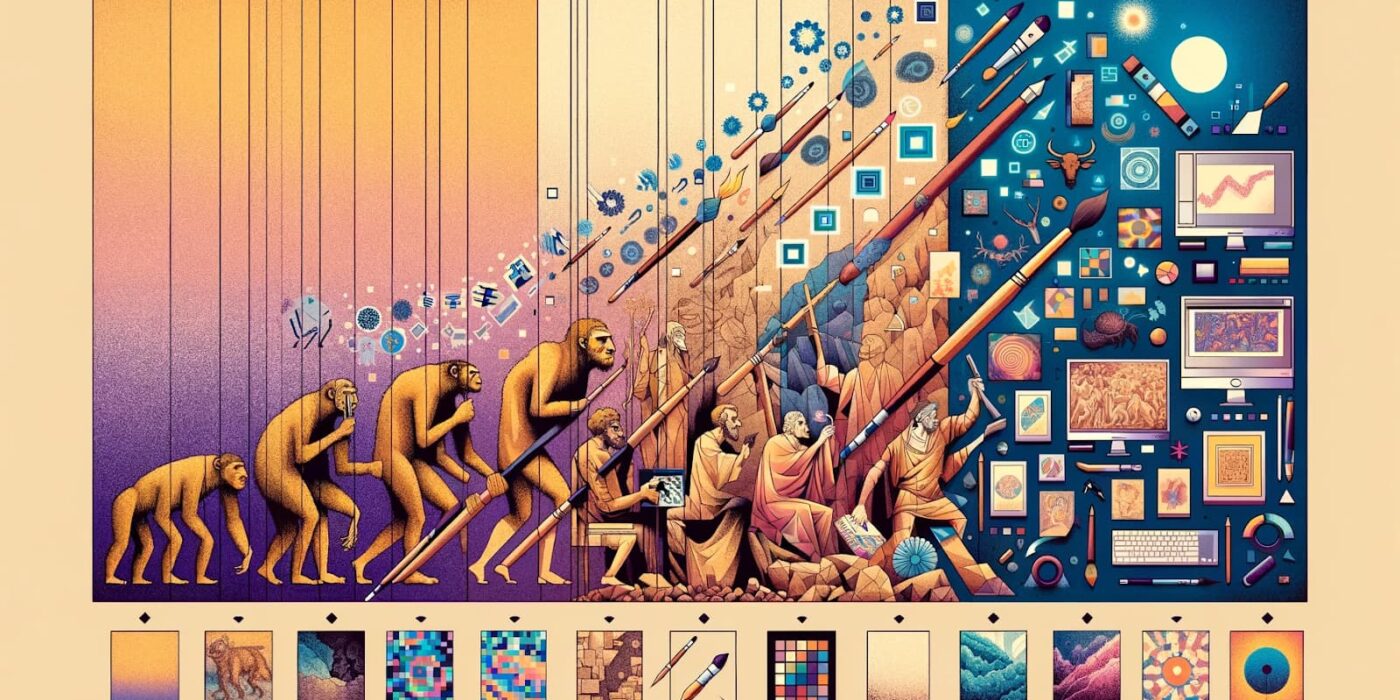Art is an integral part of human culture that has undergone a long journey of evolution from primitive cave paintings to contemporary masterpieces in museums and galleries. Studying this evolution helps us better understand and appreciate how art has formed and influenced us as a species.
Stages of Art Evolution:
- Cave Paintings: Cave paintings are one of the oldest manifestations of human artistic expression. They have been discovered in various parts of the world, dating back to the Paleolithic period, around 40,000 years ago. These paintings were created by early humans on cave walls using natural pigments such as ochre, charcoal, plant-based paints, and animal blood.
- Cave paintings reflect the life and environment of ancient hunter-gatherers. They depict animals that were hunted, plants, landscapes, as well as abstract patterns and symbols, possibly with religious or magical significance.
- These paintings not only provide us with unique insights into the lives, beliefs, and culture of ancient people but also serve as an example of early artistic evolution. They also testify to the innate human inclination towards artistic expression and creativity since ancient times.
- Ancient Art: In antiquity, art became more refined and diverse. Greek and Roman sculptors created stunning works of art depicting gods, heroes, and ordinary people.
- Ancient artists sought perfection of form and expressed ideals of beauty and harmony. Greek sculpture was renowned for its gracefulness and realism, depicting gods, heroes, and ordinary people in idealized forms. Roman art inherited many traditions of Greek art but also brought its own features, including realistic portraits and monumental architecture such as the Colosseum and the Pantheon.
- Medieval Art: During the Middle Ages, art was often associated with Christianity and the church. Magnificent cathedrals, frescoes, and icons became characteristic features of this period.
- Characteristic features of medieval art included frescoes and icons in churches and cathedrals, as well as architectural masterpieces such as Gothic cathedrals with their majestic stained glass windows and vaults.
- Renaissance: The Renaissance era in Europe, starting from the 14th century, brought a revival of interest in classical culture and ideas. Artists and architects began to study ancient works of art and use them as models for their own creations. The Renaissance was characterized by a pursuit of harmony, proportion, and realism. Leonardo da Vinci, Michelangelo, Raphael, and other masters of this time created artworks considered the greatest in the history of art.
The Renaissance in Europe brought a return to classical ideals of art. Artists such as Leonardo da Vinci and Michelangelo created incredible works of art that continue to inspire us to this day. - Modern and Postmodern: In the 19th and 20th centuries, art continued to evolve, reflecting changing social, political, and technological realities. From Impressionism to Surrealism, from Abstract Expressionism to Conceptual Art, each art movement reflects its temporal context and the development of culture.
Postmodernism, emerging in the latter half of the 20th century, is characterized by a rejection of a single style or ideology and an acknowledgment of the diversity of cultural and artistic expressions. Conceptual art, digital art, and other contemporary forms of creativity continue to develop in the modern world.
Table: Examples of Artworks from Different Historical Periods:
| Epoch | Examples of Artworks |
| Cave Art | Lascaux Cave Paintings, France |
| Antiquity | Statue of David, Michelangelo |
| Medieval | Frescoes of the Sistine Chapel, Michelangelo |
| Renaissance | Mona Lisa, Leonardo da Vinci |
| Modern | “Irises”, Vincent van Gogh |
| Postmodern | “Campbell’s Soup Cans”, Andy Warhol |
Questions and Answers:
- What factors contributed to the evolution of art over time?
- The evolution of art was influenced by various factors, including social changes, technological advancements, religious and cultural trends.
- How does art impact modern society?
- Art plays a significant role in modern society, reflecting its values, ideals, and issues through various artistic forms and expressions.
- What significance does studying the evolution of art hold for modern individuals?
- Studying the evolution of art helps us better understand our cultural heritage, develop critical thinking, and expand our artistic knowledge and taste.
- What role do modern technologies play in the development of art?
- Modern technologies open up new possibilities for artists and expand the boundaries of creativity, allowing for the creation of digital artworks and the use of interactive art forms.
- What challenges do modern artists face?
- Among the challenges facing modern artists are competition in the art market, constantly changing tastes and demands of the audience, and the necessity to navigate through the complexities of the contemporary art world.
